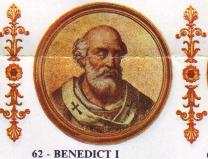
Benedict I Little is known about the life of Benedict I. He was born in Rome and was elected pope in 574. Emperor Justin did not confirm the election until the following year, at which time Benedict was officially enthroned. In 578, the pope ordained Gregory the Great to the diaconate, and over the course a four-year papacy, Benedict consecrated 21 bishops. When the Lombards invaded Rome in 579, the pope appealed to the emperor for aid. Troops and grain arrived, but the quantity was insufficient. Benedict died during the Lombard seige.
Pope Benedict I (Latin: Benedictus I; died 30 July 579) was the bishop of Rome from 2 June 575 to his death.
Benedict was the son of a man named Boniface, and was called Bonosus by the Greeks. The ravages of the Lombards rendered it very difficult to communicate with the emperor at Constantinople, who claimed the privilege of confirming the election of popes. Hence there was a vacancy of nearly eleven months between the death of Pope John III and the arrival of the imperial confirmation of Benedict's election on 2 June 575.
Benedict granted an estate, the Massa Veneris, in the territory of Minturnae, to Abbot Stephen of St. Mark's "near the walls of Spoleto" (St. Gregory I, Ep. ix, 87, I. al. 30). Famine followed the devastating Lombards, and from the few words the Liber Pontificalis has about Benedict, we gather that he died in the midst of his efforts to cope with these difficulties. He was buried in the vestibule of the sacristy of the old Basilica of St. Peter. In a ceremony held in December, he ordained fifteen priests and three deacons and consecrated twenty-one bishops.
Few of the records of transactions outside Rome that could help understand Benedict's pontificate survive, and because of the disruptions caused by the Lombards in Italy, perhaps few ever existed.





